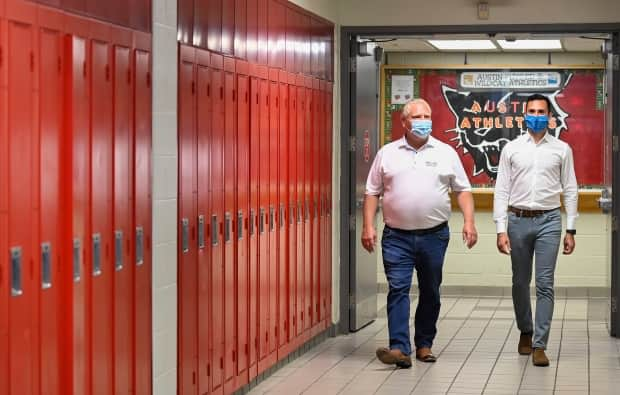Public education to suffer if teachers forced to teach 'hybrid' classes this fall, unions say

Public education will suffer in Ontario if teachers are forced to offer instruction both in-person and on-screen at the same time when schools reopen this fall, teachers' unions say.
The hybrid learning model, as it is known, is likely to be in place across the province because the Ontario education ministry has said school boards are required to offer a virtual learning option for the 2021-22 school year.
But representatives of the Ontario Secondary School Teachers' Federation (OSSTF), Elementary Teachers' Federation of Ontario (ETFO), Ontario English Catholic Teachers' Association (OECTA) and Canadian Union of Public Employees (CUPE) told reporters on Monday that they believe the hybrid model is bad news for students and teachers.
Students who choose to learn remotely should have a dedicated online teacher, they said.
Under the hybrid model, the mental health of students will continue to decline as it has during the COVID-19 pandemic, students not physically in the classroom will be shortchanged and teachers will be put under enormous stress, the union leaders said.
"Students belong in the classroom and every effort must be made to get them back there safely," Pete McKay, president of the Toronto secondary unit of OECTA, said during a virtual news conference.
Leslie Wolfe, president of OSSTF Toronto, said the hybrid model will enable the Doug Ford government to cut public education spending. She said provincial funding is not in place to ensure schools are safe this fall and to meet the demand for online learning.
"This government must stop its defunding agenda, it must stop its privatization agenda and it must properly fund schools so that every student can return safely to in-person learning in September," Wolfe said.

Wolfe said students, parents and teachers know that online learning is a "distant second" to in-person learning. The solution is a dedicated online teacher whose attention is on virtual students and whose approach and planning are not split between programming for the screen and classroom, she said.
"I want you to ask yourself: how does the science student feel fully engaged when they are sitting at home watching while their in-person peers are conducting experiments?" Wolfe asked.
"How does that music student feel while they are sitting at home with their instrument while the in-person students are practising performance, but they can't join in because of technological limitations?
"Every student in this province deserves the best education that we can provide."
Hybrid model puts teachers in 'impossible situation': union
Tui-Sem Won, president of ETFO York Region, representing 5,500 elementary school teachers, said the hybrid model is challenging when it comes to supporting the needs of special education students and it disproportionately affects marginalized children. The York Region District School Board is offering the hybrid model in the fall.
It doesn't work well when classrooms do group work, if students at home lack certain devices, or when classrooms take part in physical education, she said, adding that teachers do not have the resources to provide in-person and on-screen instruction at the same time, and that the solution is a safe return to the classroom.
"While it is possible to adapt many activities for a fully face-to-face or a fully online model, adapting for both models simultaneously puts teachers in an impossible situation," Won said.

In an interview on Monday, Ontario Education Minister Stephen Lecce said the province is seeking advice from Dr. Ronald Cohn, president and CEO of Toronto's Hospital for Sick Children, and Dr. Kieran Moore, Ontario's new chief medical officer of health, about reopening schools safely in September.
"Our commitment is get every student back into class full-time in person where they belong this September. We believe the number one priority of parents and students is the safe in class learning," Lecce said.
"But we also believe it's important for parents to make that decision and so we have required school boards to offer that choice to parents. But for the premier and myself, the focus really is getting the overwhelming majority of students back into a safe, positive, more normal environment in September."
Lecce said the province announced in May that it is providing more than $2 billion in new supports to advance and protect public education for the 2021-22 school year.
The Toronto District School Board (TDSB), in a statement on Tuesday, said it is expecting to receive more details from the education ministry this summer before it makes a decision on whether to use hybrid learning.
"The most recent information that we have received from the Ministry of Education is that all school boards must provide both an in-person and virtual option, however with case counts decreasing and vaccinations increasing, we anticipate that many more families will chose in-person in September," TDSB spokesperson Ryan Bird said in the statement.
"We anticipate receiving additional information from the Ministry with regard to health and safety measures over the summer."
As for hybrid learning, he said: "At this point in time, no final decision on the possible use of hybrid learning can be made until after the selection form information (in-person vs virtual) is received in August."

 Yahoo Sports
Yahoo Sports 